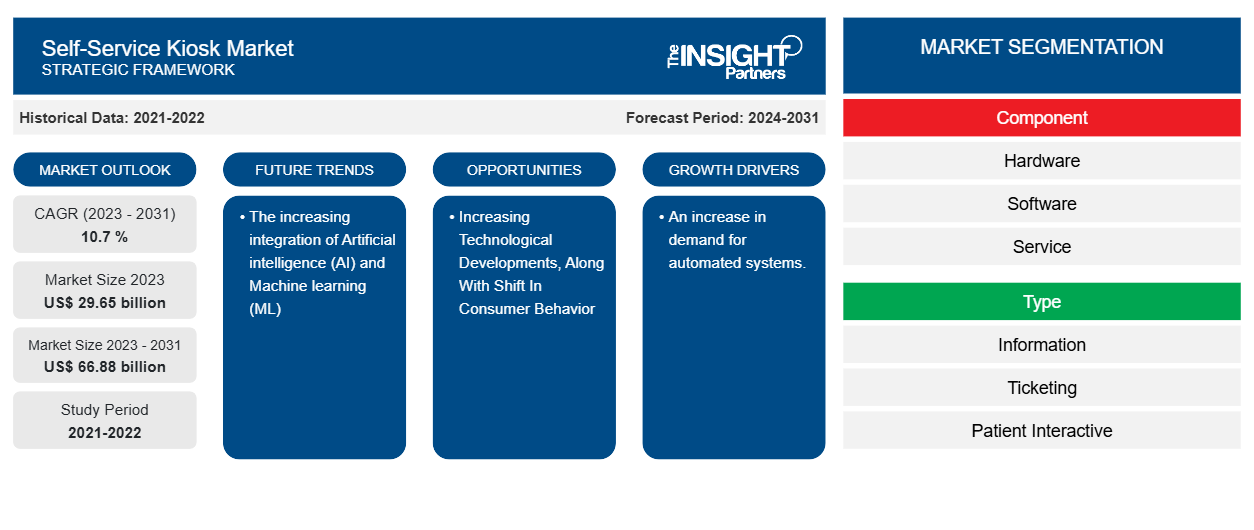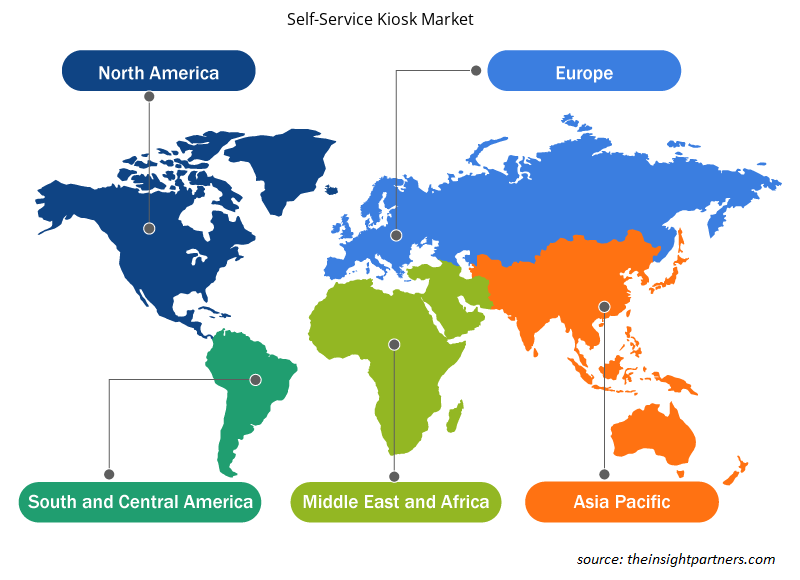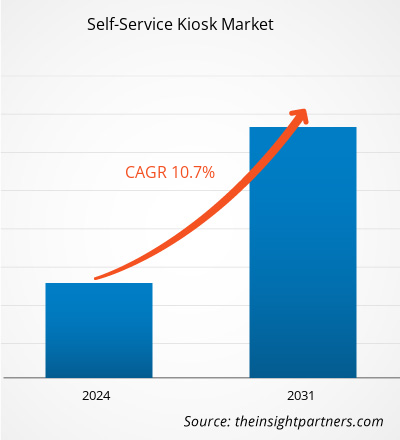The self-service kiosk market size is projected to reach US$ 66.88 billion by 2031 from US$ 29.65 billion in 2023. The market is expected to register a CAGR of 10.7 % in 2023–2031. The increasing integration of Artificial intelligence (AI) and Machine learning (ML) is likely to remain a key self-service kiosk market trend.
Self-Service Kiosk Market Analysis
Automated teller machines, ticket machines, and mobile scanners are examples of self-service technologies and services made possible by technological breakthroughs and inventions. Self-service kiosks are becoming more and more common in banks, airports, retail centers, hospitals, and theme parks. Improving customer convenience has remained the focus of the self-service kiosk industry, where innovations and technologies have been developed steadily. This trend is anticipated to continue in the years to come. The increasing number of consumers who are growing rich with advancing consumer electronics is driving the demand for self-service kiosks. Service providers have been providing a variety of self-service delivery mechanisms for many years. These include interactive voice response systems, self-service kiosks, mobile self-services, Internet-based services, and more.
Self-Service Kiosk Market Overview
In the public sector, self-service kiosks, sometimes referred to as computer terminals, are self-service devices or gadgets that allow users to interact with digital content and information via an easy-to-use interface. Interactive kiosks are used in retail sales, bill payment, wayfinding, information exchange, and tourism. These kiosks are used in many different contexts, such as the travel and healthcare sectors because they simplify the process of gathering personal data from customers.
Customize This Report To Suit Your Requirement
You will get customization on any report - free of charge - including parts of this report, or country-level analysis, Excel Data pack, as well as avail great offers and discounts for start-ups & universities
Self-Service Kiosk Market: Potrai personalizzare gratuitamente qualsiasi rapporto, comprese parti di questo rapporto, o analisi a livello di paese, pacchetto dati Excel, oltre a usufruire di grandi offerte e sconti per start-up e universitàMercato dei chioschi self-service: Approfondimenti strategici


- Get Top Key Market Trends of this report.This FREE sample will include data analysis, ranging from market trends to estimates and forecasts.
Self-Service Kiosk Market Drivers and Opportunities
An increase in demand for automated systems.
The growing need for automated systems has led to a surge in the market for self-service kiosks since these devices reduce operating time compared to manual services and generally boost customer satisfaction. Self-service kiosk technology is also being used more often in the retail industry. These innovations provide dynamic brand encounters both inside and outside of real-world establishments. Consequently, it makes sense that as interactive technologies are incorporated into retail applications, the demand for self-service kiosks will grow.
Increasing Technological Developments, Along With Shift In Consumer Behavior
Improved visualizations are provided by new technology in several industry sectors, including business, education, retail, sports & entertainment, and transportation. Interactive kiosks have the potential to draw in a large number of customers by giving them control over their purchase decisions, which will raise customer satisfaction. Technology interfaces known as self-service tools enable customers to use a service independently of a service provider. Numerous factors, such as the rise in demand for automated equipment and self-service kiosks, wireless connectivity, technical advancements, and remote management, are having a substantial impact on the self-service kiosk industry. It is anticipated that these elements will present the market with new opportunities. Thus, the increasing technological developments, along with a shift in consumer behavior, are anticipated to present new opportunities for the self-service kiosk market players during the forecast period.
Self-Service Kiosk Market Report Segmentation Analysis
Key segments that contributed to the derivation of the self-service kiosk market analysis are component, type, and end-user.
- Based on the components, the self-service kiosk market is segmented into hardware, software, and service. The hardware segment held a larger market share in 2023.
- By type, the market is segmented into information, ticketing, patient interaction, check-in, employment, and others. The check-in segment held the largest share of the market in 2023.
- By end-user, the market is segmented into retail, hospitality, healthcare, financial services, and others
Self-Service Kiosk Market Share Analysis by Geography
The geographic scope of the self-service kiosk market report is mainly divided into five regions: North America, Asia Pacific, Europe, Middle East & Africa, and South America/South & Central America. In terms of revenue, North America accounted for the largest self-service kiosk market share. In the US and Canada, consumers are more likely to buy things from kiosks. The market is expanding due to a combination of high discretionary income and the need for rapid shopping experiences with shorter wait times in lines.
Self-Service Kiosk Market Regional Insights
The regional trends and factors influencing the Self-Service Kiosk Market throughout the forecast period have been thoroughly explained by the analysts at Insight Partners. This section also discusses Self-Service Kiosk Market segments and geography across North America, Europe, Asia Pacific, Middle East and Africa, and South and Central America.

- Get the Regional Specific Data for Self-Service Kiosk Market
Self-Service Kiosk
Attributo del rapporto
Dettagli
Dimensioni del mercato in
29,65 miliardi di dollari nel 2023
Dimensioni del mercato per
66,88 miliardi di dollari entro il 2031
CAGR globale ()
Dati storici
2021-2022
Periodo di previsione
2024-2031
Segmenti coperti
By Componente - Hardware
- Software
- Servizio
By Tipologia- Informazioni
- Biglietteria
- Interazione con il paziente
- Check-in
- Impiego
By Utente finale- vendita al dettaglio
- ospitalità
- assistenza sanitaria
- servizi finanziari
Regioni e paesi coperti
North America- US
- Canada
- Mexico
Europe- UK
- Germany
- France
- Russia
- Italy
- Rest of Europe
Asia-Pacific- China
- India
- Japan
- Australia
- Rest of Asia-Pacific
South and Central America- Brazil
- Argentina
- Rest of South and Central America
Middle East and Africa- South Africa
- Saudi Arabia
- UAE
- Rest of Middle East and Africa
Leader di mercato e profili aziendali chiave - ACRELEC Group
- Embross
- Gemalto
- KIOSK Information Systems
- Meridian Kiosks
- NCR Corporation
- Olea Kiosks Inc
- Posiflex Technology Inc
- VeriFone, Inc
- Diebold Nixdorf, Inc.
| Attributo del rapporto | Dettagli |
|---|---|
| Dimensioni del mercato in | 29,65 miliardi di dollari nel 2023 |
| Dimensioni del mercato per | 66,88 miliardi di dollari entro il 2031 |
| CAGR globale () | |
| Dati storici | 2021-2022 |
| Periodo di previsione | 2024-2031 |
| Segmenti coperti |
By Componente
|
| Regioni e paesi coperti | North America
|
| Leader di mercato e profili aziendali chiave |
|
| Report Attribute | Details |
|---|---|
| Market size in 2023 | US$ 29.65 billion |
| Market Size by 2031 | US$ 66.88 billion |
| Global CAGR (2023 - 2031) | 10.7 % |
| Historical Data | 2021-2022 |
| Forecast period | 2024-2031 |
| Segments Covered | By Component
|
| Regions and Countries Covered | North America
|
| Market leaders and key company profiles |
|
Market Players Density: Understanding Its Impact on Business Dynamics
The Self-Service Kiosk Market market is growing rapidly, driven by increasing end-user demand due to factors such as evolving consumer preferences, technological advancements, and greater awareness of the product's benefits. As demand rises, businesses are expanding their offerings, innovating to meet consumer needs, and capitalizing on emerging trends, which further fuels market growth.
Market players density refers to the distribution of firms or companies operating within a particular market or industry. It indicates how many competitors (market players) are present in a given market space relative to its size or total market value.
Major Companies operating in the Self-Service Kiosk Market are:
- ACRELEC Group
- Embross
- Gemalto
- KIOSK Information Systems
- Meridian Kiosks
- NCR Corporation
Disclaimer: The companies listed above are not ranked in any particular order.

- Get the Self-Service Kiosk Market top key players overview
Self-Service Kiosk Market News and Recent Developments
The self-service kiosk market is evaluated by gathering qualitative and quantitative data post primary and secondary research, which includes important corporate publications, association data, and databases. The following is a list of developments in the market for speech and language disorders and strategies:
- In August 2021, TruMark Financial Credit Union, which has $2.7 billion in assets, selected NCR to provide its retail and business members with a smoother, uniform digital banking experience. With NCR Digital Banking, TruMark Financial will be able to offer a straightforward experience for both consumers and companies. (Source: NCR Digital Banking, Press Release)
- In October 2021, Zebra Technologies Corporation announced that it had acquired antuit.ai, a provider of Software-as-a-Service (SaaS) solutions for forecasting and merchandising for the retail and CPG sectors. (Source: Zebra Technologies Corporation, Press Release)
Self-Service Kiosk Market Report Coverage and Deliverables
The “Self-Service Kiosk Market Size and Forecast (2021–2031)” report provides a detailed analysis of the market covering below areas:
- Market size and forecast at global, regional, and country levels for all the key market segments covered under the scope
- Market dynamics such as drivers, restraints, and key opportunities
- Key future trends
- Detailed PEST/Porter’s Five Forces and SWOT analysis
- Global and regional market analysis covering key market trends, major players, regulations, and recent market developments
- Industry landscape and competition analysis covering market concentration, heat map analysis, prominent players, and recent developments
- Detailed company profiles
- Analisi storica (2 anni), anno base, previsione (7 anni) con CAGR
- Analisi PEST e SWOT
- Valore/volume delle dimensioni del mercato - Globale, Regionale, Nazionale
- Industria e panorama competitivo
- Set di dati Excel
Report recenti
Testimonianze
Motivo dell'acquisto
- Processo decisionale informato
- Comprensione delle dinamiche di mercato
- Analisi competitiva
- Analisi dei clienti
- Previsioni di mercato
- Mitigazione del rischio
- Pianificazione strategica
- Giustificazione degli investimenti
- Identificazione dei mercati emergenti
- Miglioramento delle strategie di marketing
- Aumento dell'efficienza operativa
- Allineamento alle tendenze normative




















 Ottieni un campione gratuito per - Mercato dei chioschi self-service
Ottieni un campione gratuito per - Mercato dei chioschi self-service